![]()
![]()
![]()
Use LEFT and RIGHT arrow keys to navigate between flashcards;
Use UP and DOWN arrow keys to flip the card;
H to show hint;
A reads text to speech;
116 Cards in this Set
- Front
- Back
|
Systemic vessels
(Peripheral Circulatory System) |
Transport blood through most all body parts from left ventricle and back to right atrium
|
|
|
Pulmonary vessels
|
Transport blood from right ventricle through lungs and back to left atrium
*On the RIGHT side |
|
|
Arteries are ______________ blood.
|
oxygenated
|
|
|
Pulmonary artery is _____________ blood.
|
deoxygenated
|
|
|
Vena cava is ____________ blood.
|
deoxygenated
|
|
|
Function of pulmonary circulation
|
take deoxygenated blood and oxygenate it.
Takes blood to lungs, then to heart, then to body. |
|
|
How does blood leave the heart for systemic circulation?
|
Via the aorta.
|
|
|
3 types of structures of arteries:
|
elastic, muscular, arterioles
|
|
|
Muscular and arteriole arteries have ___ elasticity and ____ muscularity.
Why? |
low elasticity
high muscularity- can vasoconstrict to maintain BP. |
|
|
2 characteristics of elastic arteries:
|
can stretch
have muscle |
|
|
The aorta is an ______ artery.
|
elastic- due to high volume of blood coming out of the heart at great force.
|
|
|
As the diameter of the artery increases, its structural property is:
|
muscular
|
|
|
What do capillary vessels interface with?
|
cells & interstitial fluid
|
|
|
Capillaries
|
Blood flows from arterioles to capillaries
Most of exchange between blood and interstitial spaces occurs across the walls Blood flows from capillaries to venous system |
|
|
Structural characteristics of veins
|
high elasticity, low muscularity
*Also have valves to prevent back flow of blood |
|
|
Most of the blood in the body is stored in the ______ system.
|
venous
|
|
|
How many layers of walls does a capillary have?
|
1, mostly endothelial (or epithelial)
endothelial cells are specific to blood vessels. |
|
|
What is happening when the capillary network is ACTIVELY metabolizing?
(local control) |
- Producing more waste
-metarterioles: vasodialation -precapillary sphincters: open |
|
|
What is happening when capillary network is LOW metabolizing?
|
- Producing small amount of waste
-metarterioles: vasoconstriction -precapillary sphincters: closed |
|
|
What is the function of arterioles, metarterioles, and precapillary sphincters?
|
Regulate flow through capillary beds.
Capillary beds can't regulate flow on their own. |
|
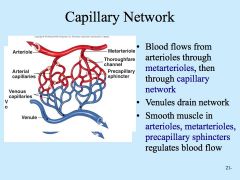
Identify: arteriole, metarteriole, pre-capillary sphincter
|
areteriole, metarteriole, precapillary sphincter
|
|

Label Tunica adventitia, tunica media, tunica intima
|
Layers are wrong on slide. Swap Intima for Media and media for Intima.
|
|
|
Arteries and veins all have three layers except for:
|
capillaries and venules
|
|
|
Tunica intima
|
Endothelium
Most apical Capillary has protective epithelium (this is the only layer a capillary has) |
|
|
Tunica media
|
Responsible for:
Vasoconstriction Vasodilation |
|
|
Tunica adventitia
|
-Most basal layer.
-Furthest away from lumen. -Routing nerve and blood vessels to vessel walls. |
|
|
Elastic arteries
|
Largest diameters, pressure high and fluctuates
Have capacity to maintain BP. Ex: Aorta |
|
|
Muscular arteries
|
Maintain BP.
Have great ability to vasoconstrict. Low elasticity. |
|
|
Arterioles
|
Transport blood from small arteries to capillaries
Low elasticity. |
|
|
Structure of Veins
|
Highly elastic so they can stretch & hold high volume of blood.
Have valves to prevent back flow. |
|
|
What is the biggest difference in layers between veins and arteries?
|
The tunica media
|
|
|
Tunica media in an elastic artery
|
very thick, can stretch and maintain BP
|
|
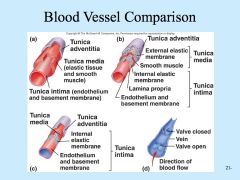
Which one is an elastic artery, muscular artery, vein?
|
a) elastic artery
b) muscular artery c) vein d) tunica intima of a vein |
|
|
Arteriosclerosis
|
decrease compliance of vessels
decrease diameter of vessel decrease blood flow |
|
|
Atherosclerosis
|
Tear in blood vessel; cholesterol + ions +etc forms plaque.
Plaque develops between tunica intima and tunica media. |
|
|
Pulmonary arteries
|
takes deoxygenated blood to the lungs from the heart
|
|
|
Pulmonary veins
|
takes oxygenated blood from the lungs to the heart
|
|
|
Arteriole system on right and left sides are not _________.
|
symmetric
|
|
|
Aorta
|
large elastic artery that leaves the heart and takes blood to the body
|
|
|
3 branches off aortic arch:
|
brachiocephalic (only on right side)
common carotid subclavian |
|
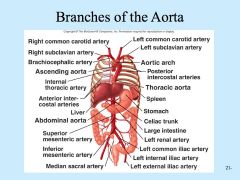
Label:
R/L common carotid artery R/L subclavian artery R brachiocephalic artery Aortic Arch Ascending aorta Thoracic aorta (descending) Abdominal aorta Common iliac artery |
common carotid goes to head
subclavian artery goes to arms |
|

Major arteries of the upper limb
subclavian axillary Brachial Brachiocephalic |
subclavian
axillary Brachial Brachiocephalic |
|
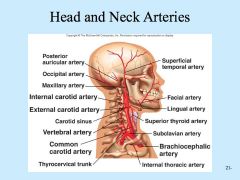
Common Carotid
Internal Carotid |
The path blood takes to the brain is:
Common Carotid Internal Carotid Brain |
|

Path blood takes to upper limb:
Subclavian artery Axillary artery Brachial Artery |
Most likely not a label question due to how small the vessels are.
|
|
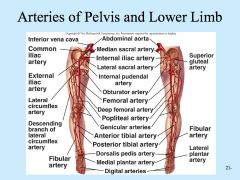
Path blood takes from the heart to lower limb:
Abdominal aorta common iliac artery external iliac artery femoral artery popliteal artery |
probably not a matching question, just know the path.
|
|
|
Major veins
|
coronary sinus (in the heart)
superior vena cava inferior vena cava *veins return blood from body to right atrium |
|
|
Coronary sinus
|
takes deoxygenated blood from the HEART to RIGHT ATRIUM
(not a matching on diagram) |
|
|
Superior vena cava takes blood from
|
head (jugular vein), neck, thorax, upper limbs
|
|
|
Inferior vena cava takes blood from
|
abdomen, pelvis, lower limbs
|
|

Focus on central structures, such as Inf/Sup Vena Cave, L/R Brachiocephalic.
Highlights of this slide: Subclavian, axillary, internal jugular, L brachiocephalic, Sup/Inf Vena Cava, External Iliac, Femoral, Popliteal |
Highlights of this slide:
Subclavian, axillary, internal jugular, L brachiocephalic, Sup/Inf Vena Cava, External Iliac, Femoral, Popliteal |
|
|
Path blood takes from head to heart:
|
Head to internal jugular to brachiocephalic to vena cava
|
|
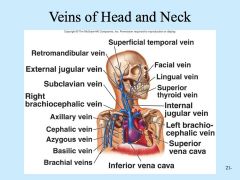
Blood leaving head and going to heart:
Internal Jugular Brachiocephalic Superior Vena Cava Enter Right Atrium |
lood leaving head and going to heart:
Internal Jugular Brachiocephalic Superior Vena Cava Enter Right Atrium |
|
|
Path blood takes from arm to heart:
|
brachial vein --> axillary vein --> subclavian vein --> brachiocephalic vein --> superior vena cava --> heart
|
|
|
Place these veins in order from proximal (closest to heart) to distal:
common iliac vein, femoral vein, popliteal vein, inferior vena cava, external iliac vein |
inferior vena cava
common iliac vein external iliac vein femoral vein popliteal vein |
|
|
Laminar flow
|
Streamlined
Outermost layer moving slowest and center moving fastest Blood flowing evenly |
|
|
Turbulent flow
|
blood not moving in laminar flow
traveling backwards a lot of blood cells in a small area |
|
|
Turbulence (as it applies to a vessel, not entire body)
-Increase Turbulence |
decrease blood flow
|
|
|
Turbulence (as it applies to a vessel, not entire body)
-Increase Diameter |
increase blood flow
|
|
|
Turbulence (as it applies to a vessel, not entire body)
-Increase compliance |
increase blood flow
|
|
|
Turbulence (as it applies to a vessel, not entire body)
-Increase peripheral resistance (decreases diameter) |
decrease blood flow
|
|
|
Turbulence (as it applies to a vessel, not entire body)
-increase vasoconstriction |
decrease blood flow
|
|
|
Turbulence (as it applies to a vessel, not entire body)
-Increase viscosity (too many RBC) |
decrease blood flow
(blood is thicker) |
|
|
Turbulence (as it applies to a vessel, not entire body)
-Increase pressure change |
Increase blood flow
can look at hand written notes on slide 21-31 for diagrams of pressure change |
|
|
Blood Pressure Measurement
What artery are you compressing? |
Brachial Artery
|
|
|
Blood Pressure Measurement
Why don't you hear sounds in beginning? |
blood flow is blocked
|
|
|
Blood Pressure Measurement
Why do you hear sounds? |
turbulant flow causes sounds
|
|
|
Blood Pressure Measurement
Why do sounds stop? |
Blood flow is laminar again.
|
|
|
Blood Pressure Measurement
What pressure reading is the first one you hear? |
systolic
|
|
|
Blood Pressure Measurement
What pressure reading is the last sound you hear? |
diastolic
|
|
|
Blood Pressure Measurement
What are the sounds called? |
Korotkoff sounds
|
|
|
Poiseuille’s Law
|
Flow decreases when resistance increases
Flow resistance decreases when vessel diameter increases |
|
|
Critical closing pressure
|
Pressure at which a blood vessel collapses and blood flow stops
Related to muscular arteries and arterioles. Keep pressure to keep vessels open. |
|
|
Laplace’s Law
|
Increase peripheral resistance, decrease blood flow
Force acting on blood vessel wall is proportional to diameter of the vessel times blood pressure |
|
|
Vascular compliance
|
Increase compliance, Increase blood flow
Veins have highest elasticity (reservoir for blood) |
|
|
What to know about blood flow in capillaries:
|
slower blood flow because:
1) they need to EXCHANGE nutrients, gases, etc 2) blood is distributed over many small vessels |
|

Look at arteries and arterioles
|
Arteries and arterioles have smooth muscle and can vasoconstrict & maintain BP
|
|
|
Ventricles are _________ during systolic pressure.
|
contracting
|
|
|
Ventricles are _______________ during diastolic pressure.
|
relaxing and filling with blood
|
|
|
Pulse Pressure
|
Difference between systolic and diastolic pressures
Increases when stroke volume increases or vascular compliance decreases Pulse pressure can be used to take a pulse to determine heart rate and rhythmicity |
|
|
Remember that capillaries have a ____ and ______ cell wall which is great for gas exchange.
|
thin and single
|
|
|
Hydrostatic pressure is related to:
|
Blood Pressure.
Arteries have a higher BP. Arterial end of capillary is higher HP Venouse end is lower HP |
|
|
In a capillary, fluid leaves vessel and enters cell due to:
|
filtration pressure
|
|
|
Blood will leave vessel and enter cells on ______ end of capillary because of a high filtration pressure
|
arterial
Net HP - OP (osmotic pressure) = net filtration pressure 33-20= 13 |
|
|
Blood will leave cells and enter capillaries on ______ end of capillary because of a low filtration pressure
|
venous
Net HP- OP= net filtration pressure 13-20= -7 (lots of waste to be removed from tissues) |
|
|
venous return
|
how much blood actually goes to heart
|
|
|
Why does venous return increase during exercise?
|
because vessels constrict during exercise
|
|
|
Local control of blood flow
|
In most tissues, blood flow is proportional to metabolic needs of tissues
|
|
|
Nervous System control of blood flow
|
Responsible for routing blood flow and maintaining blood pressure
THe heart is under constant control of parasympathetic system (trying to keep HR low) |
|
|
Hormonal Control of blood flow
|
Sympathetic action potentials stimulate epinephrine and norepinephrine
Vessels are under sympathetic control. Increase symp. control causes increase vasoconstriction. Decrease symp. control causes vasodialation. |
|
|
What causes control of local control?
|
waste products in interstitial fluid in capillary bed vessels
|
|
|
What does waste cause in precapillary sphincter and metarterioles?
|
OPENS precapillary sphincter
VASODIALATE metarteriole |
|
|
If there is low metabolic activity, what will happen to precapillary sphincter and metarteriole?
|
CLOSES precapillary sphincter
VASOCONSTRICT metarteriole |
|
|
Why is it important to control blood flow to capillaries?
|
Because they have no control over BF once it is in the capillary.
|
|
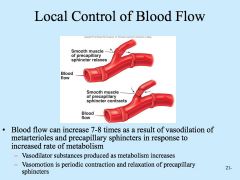
Identify precapillary sphincter & metarterioles (where it says blood flow)
|
Top figure is metabolizing
Bottom figure is not metabolizing |
|
|
(Local Control of Blood Flow)
Pericrine factors only affect area ____ __ __ |
close to it.
|
|
|
Blood vessels are only controlled by which nervous system?
|
sympathetic
|
|
|
INCREASE of sympathetic influence on vessel causes
|
vasoconstriction
caused by norepinepherine |
|
|
DECREASE of sympathetic influence on vessel causes
|
vasodialation
caused by less norepinepherine |
|
|
Baroreceptor reflexes
|
detect changes in blood pressure
|
|
|
Baroreceptors are found in
|
aortic arch & carotid body
|
|
|
Chemoreceptor reflexes
|
detect pH levels of blood
|
|
|
pH has to do with what in the blood?
|
CO2
high CO2= acidic (low pH) low CO2= alkaline (high pH) |
|
|
Why are vessels under sympathetic control?
|
To prevent collapse of vessel. Sympathetic control causes constant constriction
|
|
|
The heart is partly controlled by
|
parasympathetic nervous system
|
|
|
Baroreceptor Effects At Rest:
If blood pressure increases: |
Decrease sympathetic influence
Vessels will vasodialate Decrease BP & HR |
|
|
Baroreceptor Effects At Rest:
If blood pressure decreases: |
Increase sympathetic influence
Vessels will vasoconstrict Increase BP & HR |
|
|
T/F: There is NO parasympathetic influence in vessels.
|
TRUE!
|
|
|
Chemoreceptors: Effects of pH and Gases at REST:
High Blood pH |
Decrease sympathetic stimulation
Vessels will vasodialate Decrease blood to lungs (to keep CO2 in blood) Decrease blood pH |
|
|
Chemoreceptors: Effects of pH and Gases during EXERCISE:
Low Blood pH |
Increase sympathetic stimulation
Vessels will vasoconstrict Increase blood to lungs (to get rid of CO2 in blood) Decrease blood pH |
|
|
Under HIGHER blood pressure, blood moves _______.
|
Faster
|
|
|
If blood is ______, you want to move blood away from lungs to keep more CO2 in blood.
|
ALKALINE (low CO2)
blood will also move slower |
|
|
If blood is ______, you want to move blood to the lungs to get rid of CO2 in blood.
|
ACIDIC (high CO2)
blood will move faster |
|
|
True or False:
Arterioles act in opposite way from larger vessels. |
TRUE
This causes blood to flow more quickly due to the greater change in pressure |
|
|
If vessels are vasoconstricting centrally, then they are doing what at the capillary?
|
vasodialating
|
|
|
If vessels are vasodialating centrally, then what is happening at the capillaries?
|
vasoconstriction
|
|
|
You will have an INCREASE in blood pressure if
|
Increase in Stroke Volume (venous return)
Increase in HR Increase in Peripheral Resistance (at central vessels) |

